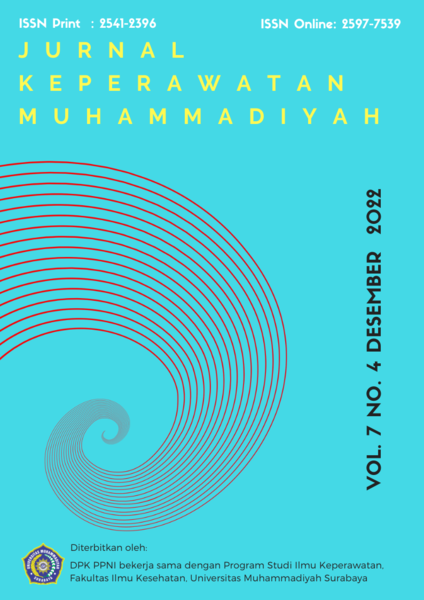Pengaruh Penggunaan Teknologi Kesehatan Terhadap Layanan Kesehatan Di Sekolah
DOI:
https://doi.org/10.30651/jkm.v7i4.15635Keywords:
health services, schools, health technologyAbstract
Background: Health services are currently very much needed. Especially for school-age children.
Objective: This study aims to determine the effect of using health technology, namely mobile applications in improving health services in schools.
Methods: This research was conducted at the Holy Faithful Obedient Elementary School Sawangan Depok in October 2022. The respondents in this study were 185 students of SD HFO Sawangan Depok. Data was collected using a questionnaire after being given training related to the use of health technology in the form of a health mobile application. Then the data were analyzed using the Paired t-test to determine the effect of using health technology with school health services.
Results: The results showed that the health service before the intervention was 29.98, after the intervention, it increased to 30.76, with a p-value = 0.001 (p < 0.05), meaning that there was a significant effect of the intervention using health technology on improving health services in Indonesia. school.
Conclusion: This research can be concluded that there is an improvement in health services in schools after being given training on the use of health technology in the form of school health mobile applications.References
Anggraini, N. V., & Hutahaean, S. (2022). Cuci Tangan Dalam Pencegahan Dan Pengendalian Infeksi Pada Masa Pandemi Covid-19. JURNAL KREATIVITAS PENGABDIAN KEPADA MASYARAKAT (PKM), 5(6), 1927–1935.
Anggraini, N. V., & Ratnawati, D. (2022). Perilaku Bermain Game Online Terhadap Insomnia Pada Remaja Di Bogor. Jurnal Keperawatan Muhammadiyah, 7(1).
Annur, C. M. (2021). Siswa SD Dominasi Jumlah Pelajar di Indonesia pada Tahun Ajaran 2020/2021. Badan Pusat Statistik (BPS). https://databoks.katadata.co.id/datapublish/2021/11/26/siswa-sd-dominasi-jumlah-pelajar-di-indonesia-pada-tahun-ajaran-20202021
Balakrishnan, R., Gopichandran, V., Chaturvedi, S., Chatterjee, R., Mahapatra, T., & Chaudhuri, I. (2016). Continuum of Care Services for Maternal and Child Health using mobile technology - a health system strengthening strategy in low and middle income countries. BMC Medical Informatics and Decision Making, 16(1), 1–8. https://doi.org/10.1186/s12911-016-0326-z
Hidalgo-Mazzei, D., Young, A. H., Vieta, E., & Colom, F. (2018). Behavioural biomarkers and mobile mental health: a new paradigm. International Journal of Bipolar Disorders, 6(1), 7–10. https://doi.org/10.1186/s40345-018-0119-7
Huriyatunnisa, A. (2022). Penerapan Adaptasi Teknologi Bagi Guru Sekolah Dasar dalam Menunjang Pembelajaran Dalam Jaringan (Daring) di Masa Pandemi. Jurnal Basicedu, 6(2), 3163–3173.
Hutahaean, S., Anggraini, N. V., Herbawani, C. K., & Apriliana, V. (2021). Analisis tingkat pendidikan dengan pencegahan penyebaran COVID-19 pada remaja. JURNAL AKADEMI KEPERAWATAN HUSADA KARYA JAYA, 7(3).
Hutahaean, S., Anggraini, N. V., Ismiyasa, S. W., Efendy, N. F., & Apriliana, V. (2021). PENCEGAHAN PENYEBARAN COVID-19 PADA REMAJA MELALUI PROTOKOL KESEHATAN. IKRA-ITH ABDIMAS, 4(3), 100–107.
Hutahaean, S., & Anggraini Nourmayansa, V. (2021). Pengaruh sikap terhadap tindakan mahasiswa dalam pencegahan dan pengendalian COVID-19. Dunia Keperawatan: Jurnal Keperawatan Dan Kesehatan, 250–256.
Kemenkes RI. (2016). Profil Kesehatan Indonesia. Kementerian Kesehatan Republik Indonesia.
Li, L., Liu, Z., Zhang, H., Yue, W., Li, C., & Yi, C. (2018). Sensors and Actuators B : Chemical A point-of-need enzyme linked aptamer assay for Mycobacterium tuberculosis detection using a smartphone. Sensors & Actuators: B. Chemical, 254, 337–346. https://doi.org/10.1016/j.snb.2017.07.074
Nimkar, S. (2016). Promoting individual health using information technology : Trends in the US health system. https://doi.org/10.1177/0017896916632790
Nuraeni, Suriana, Muliana, Ahmad, M., Syarif, S., Usman, A. N., As’ad, S., & Arifuddin, S. (2020). Stimulation of early detection and intervention of children development (SEDICD) integrated with midwife credit scores on the improvement of web-based toddler’s health services. Enfermeria Clinica, 30, 593–596. https://doi.org/10.1016/j.enfcli.2019.07.168
Prabowo, I. A. et. a. (2021). Buku Ajar : Pemrograman Mobile Berbasis Android (teori, latihan dan tugas mandiri). Lembaga Penelitian dan Pengabdian pada Masyarakat Universitas Dian Nuswantoro.
Taroreh, B. S., & Wijaya, M. A. (2020). Program Aktivitas Fisik Manipulatif Berbasis Kinestetik Untuk Anak Usia 6 Tahun. Jurnal Penjakora, 7(1), 1. https://doi.org/10.23887/penjakora.v7i1.24258
Uddin, J., Biswas, T., Adhikary, G., Ali, W., Alam, N., Palit, R., Uddin, N., Uddin, A., Khatun, F., & Bhuiya, A. (2017). Impact of mobile phone-based technology to improve health, population and nutrition services in Rural Bangladesh: A study protocol. BMC Medical Informatics and Decision Making, 17(1), 1–10. https://doi.org/10.1186/s12911-017-0502-9
Wulandari, H., & Pangastuti, R. (2020). Pengembangan Aplikasi Kesehatan Berbasis Mobile Untuk Pemantauan Deteksi Dini Tumbuh Kembang (DDTK) Anak Usia 4-6 Tahun. Al-Athfaal: Jurnal Ilmiah Pendidikan Anak Usia Dini, 3(1), 98–111. https://doi.org/10.24042/ajipaud.v3i1.6912
Downloads
Published
Issue
Section
License
- Penulis tetap memegang hak atas karyanya dan memberikan hak publikasi pertama kepada jurnal ini yang secara simultan karya tersebut dilisensikan di bawah:Â Creative Commons Attribution-ShareAlike 4.0 International (CC BY-SA 4.0)













